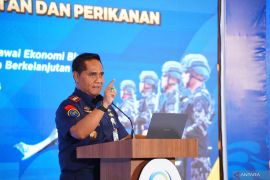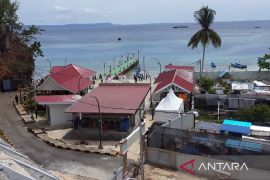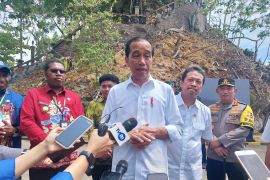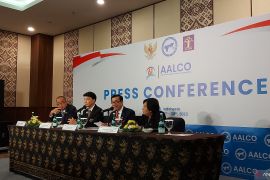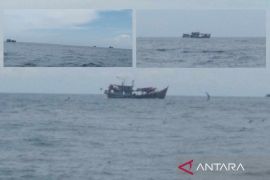Both his hands were busy cutting the thread using a cutter knife and at the same time sewing the torn net.
Sometimes, he had to stand up and use one of his legs to tighten the approximately 50-meter-long net to prevent it from getting tangled any further.
The hot weather on the Kedonganan Coast in Badung, Bali, did not stop him from maintaining one of his working tools as a fisherman.
Being a fisherman has been his main occupation since he was young, and now, he is a father to two kids.
By being a fisherman, he was able to send his oldest child to graduate from one of the vocational high schools in his hometown.
However, since the last few years, his catches have been erratic. Sometimes, he was able to bring home 15 kilograms of fish, sometimes less than 100 kilograms, and even a few fish or no results.
In one fishing trip, Ahmad usually spends Rp400 thousand, comprising Rp200 thousand to buy gasoline priced at Rp10 thousand per liter.
By using a jukung, or Balinese wooden boat, named "Rajawali 1," he sails around the waters of Uluwatu, Badung District, and usually catches mackerel tuna and lemuru fishes.
Unfortunately, Ahmad cannot expand his sailing, one of the reasons being related to the cost of buying fuel.
Other costs also include the service of pushing the jukung out to sea, the costs of loading and unloading cargo, and the costs for meeting staple needs while at sea.
In addition, he had to buy about a liter of oil mixed with petrol for his ship’s engine.
Apart from costs, the more the fuel used, the greater the level of environmental pollution that can occur.
Future hydrogen
Energy economist from the ASEAN and East Asia Economic Research Institute (ERIA) Han Phoumin said hydrogen is an important fuel that contributes to supporting clean energy in the future.
The need for clean energy is also projected to increase along with the target of carbon neutrality, or zero carbon emissions, in 2060 or sooner than the target.
Hydrogen can also be a determinant of clean energy that can be used for meeting multipurpose needs, including in the transportation sector, which is a contributor to pollution in the world.
Indonesia has a great opportunity to utilize its hydrogen production, considering there are many sources of new and renewable energy (EBT) in Indonesia that can also produce hydrogen, such as from solar power, geothermal, hydro, and wind energy.
Moreover, coal, oil, and natural gas, one of which is processed through gasification, can also produce hydrogen fuel.
The Ministry of Energy and Mineral Resources (ESDM) stated that hydrogen fuel without emissions can be used for electronic equipment, hydrogen-based electric vehicles, and large-scale electricity generation.
Meanwhile, Secretary General of the ESDM Ministry, Dadan Kusdiana, stated on the sidelines of the 41st ASEAN Energy Ministers Meeting (AMEM) and the ASEAN Energy Business Forum that Southeast Asia has an EBT potential amounting to 17 thousand gigawatts.
Meanwhile, in Indonesia, the potential for EBT is estimated at around 3,700 gigawatts, with only 12.54 gigawatts having been utilized.
The ministry then considered hydrogen's contribution in the transition from using fossil energy to clean energy in Indonesia.
In the industrial sector, the amount of hydrogen consumption per year in Indonesia is reaching 1.75 million tons, which is dominated by urea, at 88 percent; ammonia, at four percent; and oil refineries, at around two percent.
Clean energy investment
The Indonesian government has prepared a zero-carbon emission roadmap in 2060, with a target of reducing carbon emissions by up to 93 percent, from a projected 1,927.4 million tons of CO2 to 129.4 million tons of CO2 from business activities, such as industry, housing, transportation, commerce, and power generation.
One of the strategies is to utilize hydrogen as a new energy source, with a plan that in 2031-2035, green hydrogen will play an important role in reducing carbon emissions or decarbonizing the transportation sector and starting to replace natural gas in 2041-2050.
Efforts to support energy transition certainly require a lot of time and money, in addition to being driven by a big commitment from all relevant stakeholders.
ESDM Minister Arifin Tasrif stated at the 41st AMEM series in Bali that to realize clean energy transition, ASEAN countries need financing, amounting to US$29 trillion, until 2050, with a 100-percent renewable energy scheme, based on data from the International Renewable Energy Agency (IRENA).
Meanwhile, a study by the International Energy Agency (IEA) stated that Indonesia needs almost three times the investment for clean energy by 2030, namely an additional investment of US$8 billion per year.
The funding to encourage energy transition does not only come from the government but can also be achieved through innovative schemes, including mixed financing, or through government and business entity cooperation (PPP), and international funding supported by incentives, policies, and transparent procedures.
To this end, the ASEAN had agreed on 12 collaborations concerning research, financing, and development of clean energy through the 41st AMEM forum in Bali.
It is not impossible that clean energy, including hydrogen, can answer the future need for environmentally friendly and affordable energy for all levels of society.
Thus, the dream of fishermen, such as Ahmad, longing for better and more affordable energy can be realized. Apart from increasing productivity, green energy can also protect ecosystems and marine resources from the impacts of carbon emissions.
Related news: BRIN maps out national hydrogen usage strategy until 2060
Related news: KSP pegs hydrogen as more crucial energy carrier in future
Translator: Dewa Ketut S W, Resinta S
Editor: Azis Kurmala
Copyright © ANTARA 2023

